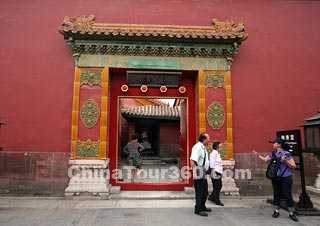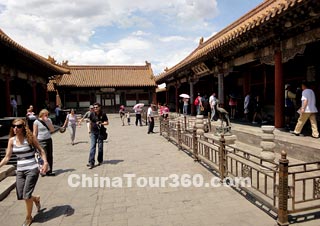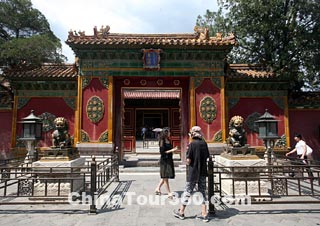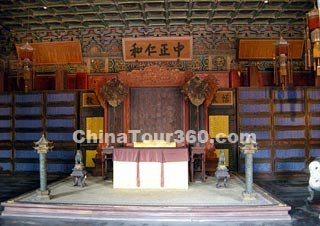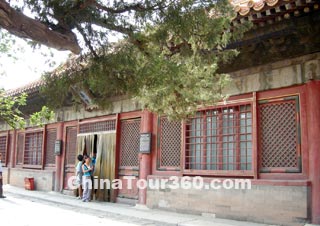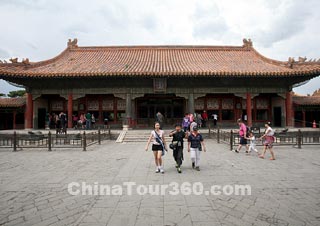Self-guided Forbidden City Tour
"West Route of Forbidden City"
- Code: FC02
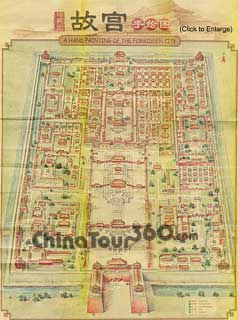 |
| Forbidden City Map |
From the Qiongyuan West Gate at the southwest corner of the imperial garden, you will reach the west part of the Forbidden City. Follow the west visiting line, you will see the living area of the emperors and empresses in the Ming and Qing dynasties and this Forbidden City tour takes about one hour's visiting time.
Walking towards south along the West Street and going through the first door on the west side, you will find Chuxiu Palace, where the Empress Dowager Cixi and the last Empress Wanrong had been living. The palace displays Cixi's 50 birthday celebrations intactly. In front of the main hall, there are a pair of deer and a pair of dragon. In Chinese culture, deer symbolizes harmony and wealth, and the implied meaning is suitable for congratulating birthday. But it is not reasonable to put the dragon here as dragon is always the symbol of monarch. From this, we can see how ambitious Cixi was. And from the Longevity Ode which had been engraved on the walls of the corridor, the eulogistic and adulatory article written by the ministers, we can see how powerful Cixi was.
Suifu Hall of Chuxiu Palace was the royal telephone office which was set in 1910 by Puyi (1906-1967) who was also known as Emperor Xuantong. Puyi ruled China as the 24th emperor of the Qing Dynasty from December 1908 to February 1912. Later between 1934 and 1945, he was Emperor Kangde of Manchukuo, actually a puppet regime of Japan. Puyi is the last emperor of China and his abdication was considered as a symbol of the end of the feudal monarchy in China. Lijing Pavilion now exhibits Puyi's daily life in the palace.
On the south side of Chuxiu Palace stands the Tihe Hall which was the dining place of Cixi in the Forbidden City. According to the record, there were 450 people serving Cixi's dining and the cost of her each meal could support a hundred thousand of families for a day. In 1887, the ceremony of choosing the empress and imperial concubines for Emperor Guangxu was held here. Among 5 ladies, Cixi prohibited Guangxu to choose the one he loved, and forced him to choose her niece, Jingfen (Empress Dowager Longyu) to be the empress, and other two ladies to be the concubines (Zhenfei and Jinfei). This event strongly proved that Cixi dominated the emperor and the country.
|
|
The next palace is Yikun, where the imperial concubines worshiped the Empress Dowager Cixi on holidays. If you see carefully, you may notice that there are several iron hoops pined in the beam. It was used to fix the swing for empress Wanrong who was a cheerful and active young lady.
Chinese ancient imperial concubines system was started from the Zhou Dynasty and lasted for almost 3000 years. In the Qing Dynasty, besides the empress, there would be many concubines like one imperial guifei, two guifei, four fei, 6 pin and indefinite number of guiren, changzai and daying, all aristocratic young ladies from layers of selection. The life in this well fortified seraglio is always a mystery to normal people. Here the exhibition in Yongshou Palace will reveal it to you. From the paintings, documents and relics, you will get to know the criteria of candidate beauties’ selection and the lifestyles of those concubines in the Forbidden City.
Yangxin Hall is at the end of the West Street. The seven rooms in the front were the work places and the five rooms in the back were the residences of the last eight emperors in the Qing Dynasty. The East Chamber is where the famous “reign behind the curtain” was taken place. The Empress Dowager Cixi had organized a coup in 1861 and wrested the political power ever since. Emperors Tongzhi and Guangxu became Cixi’s puppets and she had ruled China for 48 years. The West Chamber was where the emperor and the military ministers met and discussed the confidential affairs. If you want to know more about the Military Department of the Qing Dynasty, you may visit the historical data exhibited at the south of Yangxin Hall.
|
|
Now we walk back to visit the other 3 palaces on the west side. The one close to Yangxin Hall is Taiji Hall. Many concubines had lived here and the most famous one was Longyu, the last Empress Dowager. The document about Longyu is not so much and her personality is still controversial. We only know that because Guangxu had married her under the coercion of Cixi, he hated her very much and wreaked his anger at Cixi to her. Thus, Longyu's life in the palace was unhappy and aggrieved. After Cixi and Guangxu had died, Longyu could not handle the complicated national affairs as the regime was at the edge of breaking down. Finally in 1912, she signed the imperial abdication edict in behalf of Emperor Puyi and handed over the political power to Yuan Shikai, a warlord leader at the time. Shortly after this, in 1913, Longyu died in Taiji Hall under the great psychological pressure and chronic illness.
The next palace to the north is Changchun Palace. In its winding corridor, the vivid wall painting which used the theory of perspective is about A Dream in Red Mansions, one of the four masterpieces of literature in Chinese history. In the rear Tiyuan Hall, concubines used to enjoy the operas on holidays or birthdays. The last master of Changchun Palace was Shufei Wenxiu, the concubine of Puyi. Just like her name, Wenxiu was an introverted and quiet girl. She became Puyi's concubine when she was only 13 in 1922, and had lived here for only 3 years. As she had no love for Puyi and often been pushed aside by Empress Wanrong, in 1931, Wenxiu had been brave enough to divorce with Puyi and became a civilian.
|
|
The last stop of the west route of Forbidden City tour is Xianfu Palace. Ancient China was a patriarchal society, while Empress Dowager Cixi could control emperors Tongzhi and Guangxu, manipulate the country and be the most powerful woman in China for 48 years, you must wonder her abilities and means. An exhibition of the relevant historical relics and data in Xianfu Palace will describe this part of history in details. Cixi became an imperial concubine of Emperor Xianfeng in 1852 and gave birth to his only son in 1856. Xianfeng died in 1861. Then when her son, Tongzhi who was only 6 became the emperor, Cixi had started her reign till she died in 1908.
By visiting the residences of the emperors and empresses in the Forbidden City, you will better know about their lives and understand the history.
- More Self-guided Forbidden City Tours:
- Central Axis Route of Forbidden City
- East Route of Forbidden City
- Outer East Route of Forbidden City
- Beijing Tours including the visit to Forbidden City:
- Essence of Beijing: 5-Day Beijing Tours
- Essence of China: 8-Day Small Group of Beijing - Xian - Shanghai
- China Essence & Yangtze Cruise: 12-Day Yangtze River Cruise to Beijing - Xian - Chongqing - Yangtze River Cruise - Yichang - Shanghai



